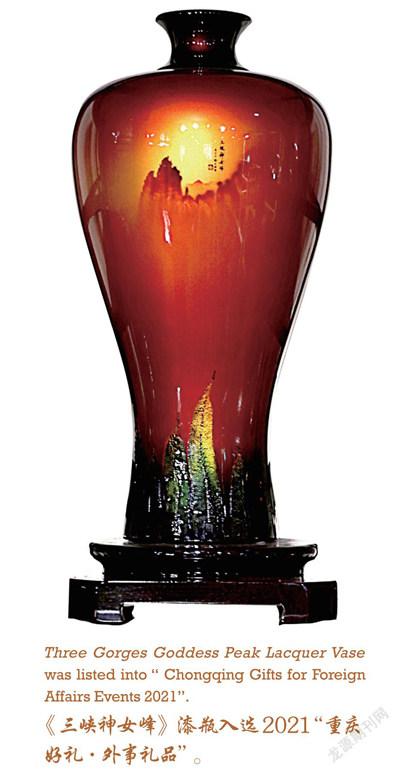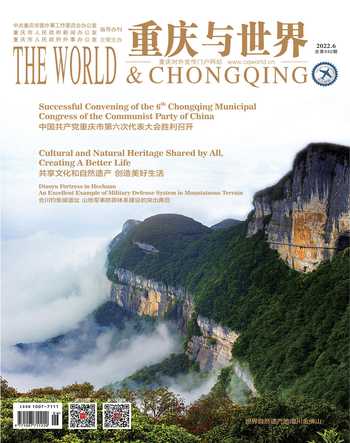山神漆器&三峽神女峰漆瓶 大山獻出的國禮
劉丁睿




Shanshen Lacquerware & Three Gorges Goddess Peak Lacquer Vase
State Gifts From the Mountain City
Lacquerware, embroidery, pottery, stone carving, paper-cutting...A dazzling variety of intangible cultural heritage handicrafts are exhibited for the reviewing of the first batch of selected traditional artworks and handicrafts in Chongqing. When preparing the exhibition, Cai Zerong, president of Chongqing Industrial Arts Association, was onsite to give instructions for exhibition arrangements and to communicate with exhibitors. He is known as a master of Chinese craft and arts, a representative inheritor of the wooden lacquer art in Chengkou, Chongqing.
In Chongqing Shanshen Lacquer Art Museum, hundreds of pieces of lacquerware are exhibited, including lacquer vases, lacquer plates, lacquer paintings, folding screens extending a few meters and palm-size teacups. It is breathtaking how exquisite they are, as shiny as the pearl, as smooth as the silk. Among them, a lacquer vase is outstanding, with featured elements of the Three Gorges. Cai Zerong said “this craft is Three Gorges Goddess Peak Lacquer Vase inspired by the legend of Wushan Goddess Peak. Elegant and delicate, the ware reminds us that Chongqing is a beautiful city of lush mountains and lucid rivers.”? Visitors will think of Chongqing whenever they see the state gift.
Chengkou Lacquerware
Chengkou County, boasting the highest forest coverage rate in Chongqing, grows the lacquer trees, one of the top five lacquers in China. This land is warm in winter and cool in summer with good air quality, providing favorable climate and environment for producing high-end lacquerware.
“Lacquer art has a long history in China. In ancient times, lacquerware was not only used in daily life, but also used as the offering in important occasions such as sacrifice. Chengkou lacquerware is historically known as the lacquerware of Ba, dating back to 3,000 years ago according to archaeological findings. In modern times, lacquer art is widely adopted in houses decoration, furniture producing, especially the furniture used as dowry. In Chengkou, lacquerware can be found everywhere in the life of the local people.” This experience kindled Cai Zerong’s interest in lacquer art when he was young and he started his apprenticeship in his teens.
According to Xiu Shi Lu (Records of Traditional Lacquerware), there are 471 techniques of lacquer art, including engraved gold, filled-in lacquer, carved lacquer, and rhino skin. Producing lacquerware takes a long time. After being lacquered, a ware needs to be dried for 7-10 days before the next process, and over a hundred of processes are required to decorate a ware. Making a piece of lacquerware may take at least one to two months or three to five years at most. For large-scale and complicated works, teamwork of more than 10 artisans is required.
“It is true that once you’ve made up your mind, perseverance is needed to finish the endeavor. Lacquer art has been passed down in China for thousands of years. Now it is our mission to further inherit it.” Said Cai Zerong, “Since the day I took up lacquer art, it has become my lifelong dedication.”
Lacquerwares as Gifts
Shanshen lacquerware, literally the lacquerware of mountain god, is a product of nature and represents the charm of mountains. In 2010, Chengkou lacquerware was listed as Intangible Cultural Heritage of Chongqing. In 2015, Shanshen Lacquerware was honored as “Protected Eco-origin Product of China”, receiving the Golden Awards of China Tourism Commodities Competition for many times. In 1993, Cai founded the Chongqing Shanshen Lacquerware Co., Ltd., expanding it from a small factory to an industrial park. Now, Shanshen Lacquerware has grown into a well-known Chinese brand with global fame.
Lacquerwares named Five Cattles in Golden Field, and Five Blessings achieved awards of craft designs at home and abroad successively. The Three Gorges Goddess Peak Lacquer Vase and other delicate works have been sent to foreign guests as state gifts. This lacquer vase also served as a gift to present China’s craftsmanship in many foreign affairs events, such as the Annual Meeting of the Chongqing Mayor’s Advisory Council, Asia-Pacific Cities Summit and ASEAN-China Ministerial Meeting.
Ushering into a Better Future
In 2019, the training class of Shanshen Lacquerware (intangible cultural heritage) to alleviate poverty was opened. With the operation mode of “company + impoverished people + lacquer craft”, this class aimed to develop and inherit the intangible cultural heritage, and to drive employment. “Traditional craft is born from innovation, and Shanshen Lacquerware is no exception. A strong sense of crisis will appear if we don’t come up with new ideas or make progress.” As a leader of craft? and arts in Chongqing, Cai often thinks about the way to inherit the Chengkou lacquer art, and to research and develop cultural creative lacquer ware with great popularity. He also thinks about the way to integrate intangible cultural heritage with rural revitalization and promote its harmonious development with cultural tourism.
Cai said that “now, lacquerware has changed from common household goods to souvenirs and collections. Its good implication brings people great joy of life.” He was playing with his new work, a scarlet red lacquer vase, with gentleness and determination in his eyes. “Going forward, we plan to establish a lacquerware museum to introduce the artwork to the public, providing a platform for more people to appreciate and get to know the charisma of lacquer culture.”
Photo/Interviewee
漆器、繡品、陶器、石雕、剪紙……精美的非遺工藝品讓人目不暇接,在重慶市首批傳統工藝美術精品評審布展現場,重慶市工藝美術行業協會會長蔡澤榮一邊指導展品擺放,一邊與送展人交流。他還有另外的身份:中國工藝美術大師、重慶城口木胎漆器制作技藝非遺代表性傳承人。
在重慶山神漆器藝術館,記者看到這里陳列著上百件漆器作品,除了漆瓶、漆盤、漆畫,還有大到寬數米的屏風,小到手握的茶杯。漆器表面流光溢彩,質感精致細膩,色彩鮮艷明亮,觸感如絲綢般順滑,精美程度令人驚嘆。其中,一件融合三峽元素的漆瓶格外亮眼。“這件作品叫做三峽神女峰漆瓶,以巫山神女峰為背景,整體典雅細膩,蘊含重慶‘山水之城,美麗之地’之意。”蔡澤榮介紹說,客人看到這件禮品,就會想到重慶,記住重慶。
城口之漆
城口縣森林覆蓋率居重慶第一,這里生長的大木漆更是中國五大名漆之一。城口的氣候冬暖夏涼,空氣質量優良,為生產優質漆器提供了得天獨厚的自然條件。
“中國制造漆器歷史悠久,古代漆器不僅是日常用品,也用于祭祀等重要場合。城口漆器在歷史上又稱巴國漆器,考古發現距今已有3000年的歷史。在近代,漆藝的利用與房屋、家具,尤其是婚嫁中的陪嫁家具結合得更多,漆器在我們當地人的生活中無處不在。”耳濡目染下,蔡澤榮從小就對漆藝產生興趣,十多歲便拜師學藝。
據《髤飾錄》記載,漆藝有471種技法,常見的有描金、填漆、雕漆、犀皮等。漆器的制作周期非常長,每上一遍漆要干燥7~10天才能進行下一道工序。裝飾環節需要上百道工序。要做好一件漆器,費時少則一兩個月,多則三年五載。面積較大、工藝復雜的漆器,往往需要集合十余人的團隊力量才能完成。
“現在想來很有道理,干一件事情就要一條路走到底。幾千年都沒有消失的東西,更需要我們把它傳承和發揚下去。”蔡澤榮說,“既然入行做了漆工,深耕漆藝文化就是我一輩子的事業。”
漆器之禮
山神漆器,寓意是大自然的產物、山的神韻。2010年城口漆藝入選重慶市非物質文化遺產名錄;2015年山神漆器獲“中華人民共和國生態原產地保護產品”稱號,并多次獲中國旅游商品大賽金獎。1993年,蔡澤榮創辦“山神漆器”,把一個小廠房做成了一個產業園。“山神漆器”已成長為中國著名品牌,產品遠銷國外。
其中,《金地五牛》《五福臨門》等漆器作品相繼獲得國內外多項工藝設計大獎;《三峽神女峰》漆瓶等精品被當做國禮贈送外賓。《三峽神女峰》漆瓶更是在重慶市市長國際經濟顧問團會議、亞太城市市長峰會、東盟外長會等外事活動中作為贈禮,向世界展示中國工匠精神。
美好之物
2019年,山神漆器技藝非遺扶貧培訓班開班,通過“公司+貧困群眾+漆器技藝”的運營模式,實現非遺傳承發展、非遺帶動就業。“傳統工藝都是創新而來的,山神漆器也是如此。如果幾個月都沒有新的思路,技術也停留在原地,我就會有深深的危機感。”作為重慶工藝美術行業帶頭人,蔡澤榮時常思考,如何做好城口漆藝的傳承、漆器文創品的研發,以及非遺與鄉村振興的結合促進、與文旅的融合發展。
“如今,漆器由普通的家居生活用品向紀念品、珍藏品轉變,它們的美好寓意帶給人們美好生活的享受。”蔡澤榮用手摩挲著他最新創制的大紅漆瓶,目光柔和又堅定,“接下來,我們還將打造漆器博物館,讓漆器走進大家的視野,讓更多的人認識和了解漆文化的魅力。”
部分圖片/受訪人提供

